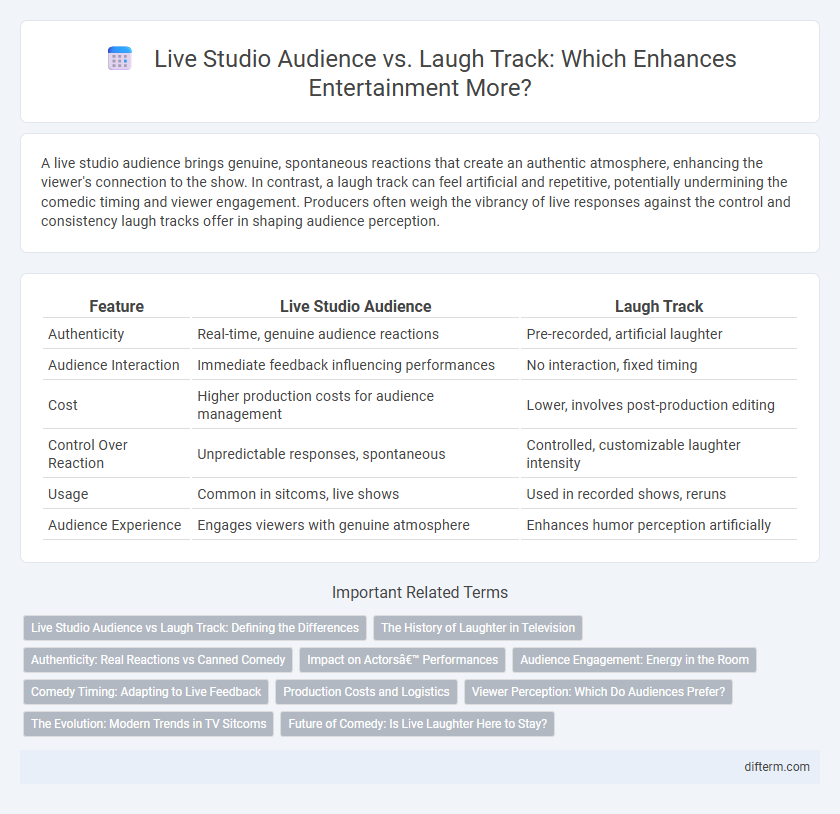A live studio audience brings genuine, spontaneous reactions that create an authentic atmosphere, enhancing the viewer's connection to the show. In contrast, a laugh track can feel artificial and repetitive, potentially undermining the comedic timing and viewer engagement. Producers often weigh the vibrancy of live responses against the control and consistency laugh tracks offer in shaping audience perception.
Table of Comparison
| Feature | Live Studio Audience | Laugh Track |
|---|---|---|
| Authenticity | Real-time, genuine audience reactions | Pre-recorded, artificial laughter |
| Audience Interaction | Immediate feedback influencing performances | No interaction, fixed timing |
| Cost | Higher production costs for audience management | Lower, involves post-production editing |
| Control Over Reaction | Unpredictable responses, spontaneous | Controlled, customizable laughter intensity |
| Usage | Common in sitcoms, live shows | Used in recorded shows, reruns |
| Audience Experience | Engages viewers with genuine atmosphere | Enhances humor perception artificially |
Live Studio Audience vs Laugh Track: Defining the Differences
Live studio audiences provide genuine, real-time reactions that enhance the authenticity of sitcoms and variety shows, creating an engaging atmosphere for both performers and viewers. Laugh tracks, on the other hand, are pre-recorded laughter inserted during post-production to simulate audience responses, often criticized for lacking spontaneity and emotional depth. The key difference lies in the spontaneity and interaction live audiences bring, versus the controlled, consistent nature of laugh tracks designed to guide viewer reactions.
The History of Laughter in Television
The history of laughter in television reveals a pivotal shift from live studio audiences to laugh tracks, evolving to maintain audience engagement and comedic timing. Live studio audiences originated in early sitcoms like "I Love Lucy," providing genuine, spontaneous reactions that enhanced the viewing experience. Laugh tracks, introduced in the 1950s by sound engineer Charles Douglass, enabled shows without live audiences to simulate laughter, standardizing humor cues across diverse television formats.
Authenticity: Real Reactions vs Canned Comedy
Live studio audiences provide authentic reactions with genuine laughter, enhancing the spontaneity and energy of comedy shows. Laugh tracks, on the other hand, use pre-recorded canned laughter that can sometimes feel artificial and diminish the natural timing of jokes. The authenticity of live feedback often improves viewer engagement by creating a shared communal experience absent in laugh track productions.
Impact on Actors’ Performances
Live studio audiences provide immediate feedback through laughter and applause, creating a dynamic energy that encourages actors to deliver more spontaneous and authentic performances. In contrast, laugh tracks offer pre-recorded reactions that can sometimes lead actors to rely on timing cues rather than genuine audience interaction, potentially making performances feel less vibrant. The presence or absence of a live audience significantly influences actors' emotional expression, pacing, and overall engagement in a scene.
Audience Engagement: Energy in the Room
A live studio audience generates authentic laughter and spontaneous reactions, creating dynamic energy that enhances the viewing experience and increases audience engagement. The presence of real-time audience responses stimulates actors' performances, fostering a vibrant atmosphere that a laugh track cannot replicate. Laugh tracks, while consistent, lack the unpredictability and emotional connection that live audiences bring, often resulting in a less immersive entertainment experience.
Comedy Timing: Adapting to Live Feedback
Live studio audiences provide comedians with immediate reactions, allowing precise adjustments in comic timing to enhance punchlines and physical cues. Laugh tracks simulate audience responses but lack the dynamic energy that helps performers gauge which jokes resonate, sometimes resulting in less natural pacing. Real-time feedback from live audiences is crucial for refining delivery, ensuring the humor lands effectively within sitcoms and variety shows.
Production Costs and Logistics
Live studio audiences often increase production costs due to the need for larger studio spaces, audience coordination, and additional staff for crowd management. In contrast, laugh tracks are more cost-effective, requiring minimal setup and eliminating the need for live audience logistics. The choice between the two impacts scheduling flexibility and post-production efforts, with live audiences demanding real-time synchronization.
Viewer Perception: Which Do Audiences Prefer?
Live studio audiences create authentic reactions that enhance viewer engagement by providing genuine laughter and spontaneous energy, making scenes feel more relatable and immersive. Laugh tracks, while consistent and controlled, often lead viewers to perceive humor as forced or less natural, which can reduce emotional connection and enjoyment. Audience research indicates a growing preference for live studio audiences, as they foster a stronger sense of community and realism in entertainment programming.
The Evolution: Modern Trends in TV Sitcoms
Live studio audiences create authentic laughter that enhances viewer engagement by capturing real-time reactions, while laugh tracks offer controlled, consistent humor cues in post-production. Recent trends in TV sitcoms show a hybrid approach, blending live audience recordings with laugh tracks to maintain spontaneity and production flexibility. This evolution reflects the industry's adaptation to changing viewer preferences and advances in sound design technology.
Future of Comedy: Is Live Laughter Here to Stay?
Live studio audiences provide real-time reactions that enhance comedic timing and authenticity, creating a dynamic atmosphere unmatched by laugh tracks. Advances in interactive technology and streaming platforms suggest a growing preference for genuine audience engagement, signaling that live laughter remains a cornerstone of comedy's evolution. As viewer demand for authenticity rises, the future of comedy favors preserving live audience responses over artificial laugh tracks.
Live studio audience vs Laugh track Infographic

 difterm.com
difterm.com